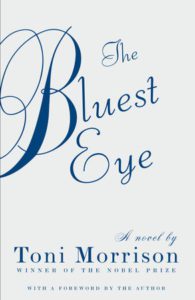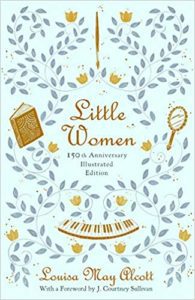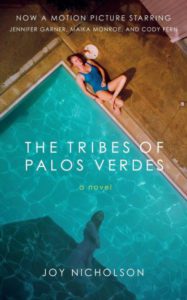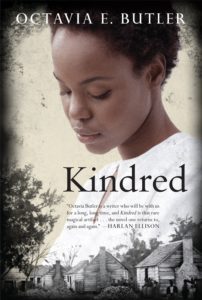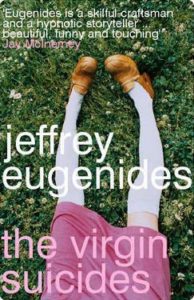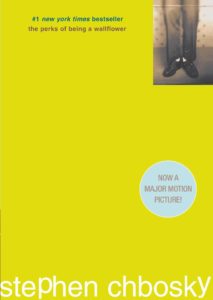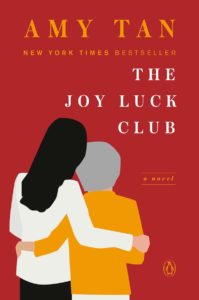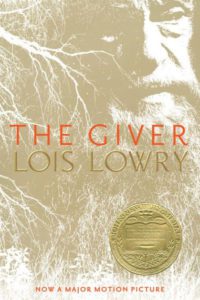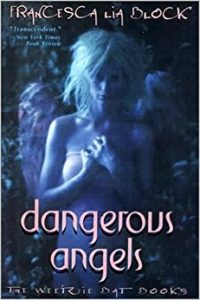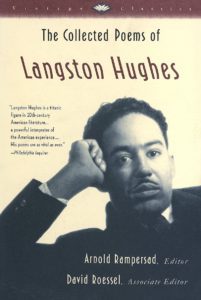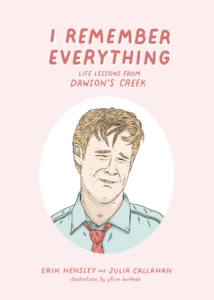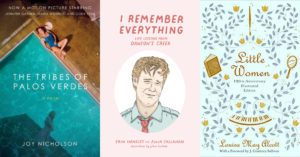
In times of unknown, there can be great solace in revisiting comforts from your past.
We met a few days after September 11 in the dorms of UC Santa Cruz, but we became friends a few weeks later when fate aired a commercial for Dawson’s Creek in our presence and we made plans to watch the episode together. Our weekly viewings turned into a nearly two-decade-long friendship. When we both found ourselves looking for a new creative project, we turned back to where we began and started a re-watch podcast, Dawson’s Critique. Now, after all those years of talking about the show, we have put our thoughts on to paper in our forthcoming book, I Remember Everything: Life Lessons from Dawson’s Creek.
Dawson’s Creek is known to many for its iconic Dawson crying face meme. Fans of the show know that famous sob happens after Dawson, a privileged white dude, utters “you’re free” to Joey Potter. As in, you’re free to choose to move forward with your life and make your own decisions, i.e. sail away with friend to women Pacey Witter. It’s interesting to us that the most famous thing from this show is a white man “freeing” a woman. It barely worked in 2000, and it definitely doesn’t hold up now—which, in a way, is good.
That’s the thing about revisiting the past: you remember how much has changed for the good. You remember that not everything comes with two-day free shipping. You remember how your favorite characters are the “others.” You remember the pain of the queer kid coming out and the excitement of the first gay kiss on network television, the trauma of being sexualized young and how to create your own sexual identity, the struggle of growing up poor and the excitement of getting out on your own. And, you realize the privileged man was never the star of the show.
Below, we remember the books we read while growing up and watching Dawson’s Creek, from 1998–2003.
***
The Bluest Eye by Toni Morrison
Coming to Toni Morrison in high school is an interesting prospect. Her writing is so rich and almost impressionistic that, for a younger reader, it can feel a little out of reach. But I return to her books again and again as I age, and each time I reread them, I glean something new. Reading Morrison in high school and not fully understanding has now given me the experience of reading Morrison with more understanding each time I return to her work. And how lucky we are to be able to return over and over to these rich stories! The Bluest Eye’s discussion of beauty, and how we internalize societal standards, helped to shed light on the struggles I had in high school. – Erin
Little Women by Louisa May Alcott
Dawson’s tomboy best friend, Joey, is arguably the star of the series by the time season 6 comes to an end. We know from the get-go that Joey’s name is short for Josephine, but finally, in season 3, we learn that she is named after Jo March from Little Women. A book my mother read to me when I was a kid, and one that I revisit and love deeply, Little Women is like that comfy blanket that I sometimes need to cuddle up with. – Julia
The Tribes of Palos Verde by Joy Nicholson
The Tribes of Palos Verdes was one of those books that your friend handed to you at lunch; I have no recollection of ever buying this book, though I’m looking at a copy on my bookshelf now. It’s almost as if it appeared on my bookshelf and in my life through some kind of teen miracle. Nicholson pens a deeply felt story about a girl who didn’t fit in and whose family was falling apart, set starkly against the backdrop of California’s coastal beauty. Both of us grew up in California and so this novel felt so familiar—the darkness of teendom set in contrast to the beauty of the West Coast was something we both lived. – Erin
Kindred by Octavia Butler
At my high school, when we read The Adventures of Huckleberry Finn, we could also choose to read Kindred or Their Eyes Were Watching God. I read Huck Finn, and then put the others in my TBR pile. When I read Kindred later that year, I realized that I had chosen wrong in which book to read first. Kindred is a deep examination of the brutal side of America and delves straight into the racism of the country, offering an understanding that I just didn’t get out of Huck Finn. Butler’s novel is so beautifully wrought, and has stayed with me all these years. In many ways, it was my first real foray into examining our history of racism and slavery, and thinking about how that history shapes the American experience to this day. – Julia
The Virgin Suicides by Jeffrey Eugenides
As weird, arty high school kids in the late ‘90s, the movie adaptation of The Virgin Suicides provided the literal soundtrack to our lives. The score by Air seemed to permeate every space, every coffeehouse, every afternoon spent lying on the floor of our friends’ bedrooms. But of course, the movie pushed us all to read Eugenides’s wonderful novel, and to think about how too often the story of women is told through the eyes of the men that are obsessed with them, and how too often women’s stories are not our own. – Erin
The Perks of Being a Wallflower by Stephen Chbosky
I have a tattoo from this book. Chbosky’s novel came out when we were fifteen and is another of those books that felt like it suddenly appeared on you shelf, passed along from someone. I distinctly remember reading the book and looking out my bedroom window during a rainstorm, feeling so seen by this story of a group of weird theater kids who stage Rocky Horror Picture Show and find community with each other. This was also the first book I read with an out queer character, and much like the acceptance of Jack in Dawson’s Creek, Patrick in Perks was accepted by his friend group easily. I felt a deep connection to his story, and to this novel. – Julia
The Joy Luck Club by Amy Tan
I grew up near San Francisco, and when I was older in high school, I would ditch class with my friends and go to the city for the day. Often that meant hanging on Haight Street and going to Amoeba Records, or buying vintage clothes at the consignment shops nearby, but sometimes we’d spend the day at City Lights Bookstore. City Lights is in North Beach, next to Chinatown, so this often meant we would spend lunch eating at Sam Wo’s (RIP), which any San Franciscan will tell you was an experience unto itself. I read The Joy Luck Club in high school, and those trips to Chinatown would often end with me walking down quiet alleys listening for the soothing clacking of mahjong tiles. It always brought me right back to Tan’s scenes of immigrant families in the close quarters of San Francisco’s Chinatown. These walks offered a quiet, rhythmic respite from the busyness of Chinatown’s main thoroughfares, and a kind of acknowledgement that culture prevails even as it morphs when transplanted to America. I still sometimes walk down those alleys and listen. It soothes me to this day. – Julia
The Giver by Lois Lowry
This book cemented my love of dystopian fiction. I often revisit it in times of change. As the Giver unloads all of society’s memories to the novel’s protagonist Jonas, we learn that every painful sunburn was worth that beautiful day sledding down a snowy hill. Our collection of memories and experiences make us who we are. As Jonas comes to see his world through his own eyes, he realizes the utopia he thought he lived in was all lies, and even worse, his parents have been lying to him about said utopia. Kind of like the whole, go to college, get a job, buy a house thing I was told… – Erin
Dangerous Angels (The Weetzie Bat Books) by Francesca Lia Block
My friend, who I used to watch Dawson’s Creek with in high school, came up to me one day at lunch and handed me Weetzie Bat, the first in Block’s series about Weetzie and her group of friends. I read the entire book while sitting in the back of the next class I went to. I was hooked. I read every book in the series, over and over again. These were the first books that let me in on the fact that Los Angeles might be a city I wanted to move to, and much like Dawson’s Creek, these books emphasized the strength that comes from making our own chosen family. – Julia
The Collected Poems of Langston Hughes by Langston Hughes
I saw the musical Rent in San Francisco when I was fifteen (in 1999), and it was like being hit by a meteor in the best way possible. It felt like the thing I had been searching for my whole life, which is a big deal when you’re fifteen. I wore the soundtrack out twice on CD, I played it so much. I remember clearly going through the lyrics to the song “La Vie Boheme” and looking up every reference within it. If you know the song, you know that much of it is basically a list of artists and cultural icons and events. Then I got to Langston Hughes (high five if you just sang “to the stage” in your head; let’s have drinks sometime). My mom worked at UC Santa Cruz so I went to the UCSC library and checked out this collection of Langston Hughes’s poems. I was never a big poetry reader, but discovering the power and emotion of Hughes’s writing and of the experience and time he was writing about opened up the world to me. I’ve never looked back. – Julia
And to close out this wonderful list, we just had to include Erin and Julia’s new book, I Remember Everything: Life Lessons from Dawson’s Creek, out on October 27 from Rare Bird Books! – Ed.
I Remember Everything: Life Lessons from Dawson’s Creek by Erin Hensley and Julia Callahan, with illustrations by Jillian Barthold
The first coming-of-age series for millennial consumption, Dawson’s Creek created one of the most iconic memes before the word “meme” was mainstream. On January 20, 1998, the Capeside High School class of 2001 came into our lives. Dawson’s Creek centered around the titular star―a white man with a lot of privilege―who proved to be anything but our hero. Our heroes were Jen Lindley, the “big city vixen” who turned out to be the third-wave feminist we desperately needed; Pacey Witter, the “lovable loser” and underdog we rooted for the entire series; and Joey Potter, the “poor tomboy” from the wrong side of the Creek who demonstrated what personal strength and independence could accomplish. Pulling quotes from all six seasons, I Remember Everything dissects the main themes of Dawson’s Creek: sex, mental health, relationships, classism, queerness, and much, much more.

